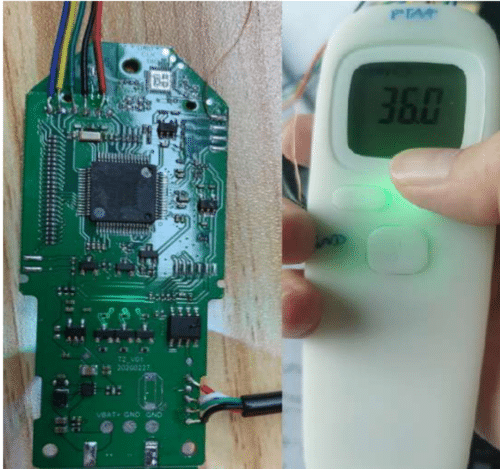The design for a forehead thermometer features a microcontroller with ADC, power management, and connectivity for healthcare applications.

The reference design from NXP semiconductor for a forehead thermometer is based on the K32L2B microcontroller. It is a sophisticated solution tailored for cost-sensitive and low-power battery-operated applications. This design is centred around a 48 MHz ARM Cortex-M0+ core and supports 256K flash memory, making it powerful yet efficient. The MCU series stands out with its rich blend of analogue peripherals and digital interfaces, geared explicitly towards applications where minimising cost and power usage is crucial.
One of the key features of this design is its integrated multi-channel 16-bit ADC (Analog-to-Digital Converter). This ADC is crucial for collecting signals from the infrared temperature sensor and measuring battery voltage. The accuracy levels of the MCU’s ADC are quite high, achieving 13.9 bits in single-ended mode and 14.5 bits in differential mode. Such precision allows the thermometer to reach an impressive temperature measurement accuracy of 0.1 degrees.
The design also includes a 12-bit DAC (Digital-to-Analog Converter), which provides bias voltage to external operational amplifiers. This DAC negates the need for an external level conversion chip, and it can also supply a 1.2V reference voltage with a load capacity of 1 mA. Additionally, the design incorporates a low-power SLCD (Segment LCD) display, supporting 24×8 or 28×4 segments. The SLCD pins are versatile, functioning as segment and common ports or for other IO functions.
Connectivity in this design is enhanced through the inclusion of three I2C channels. These channels are configured such that one connects to an infrared digital sensor or proximity sensor, another to a high-precision digital temperature sensor like the PCT2075, and the third, using FlexIO, can be set up for standard I2C, UART, or SPI communications. Furthermore, the design uses PWM (Pulse Width Modulation) for driving LED indicators or buzzer alarms and can support voice playback functions.
The USB interface is another highlight, featuring a USB FS 2.0 device interface that operates without an additional crystal. Regarding memory and power efficiency, the K32L2B11VLH0A variant with 64K flash and 32K RAM is particularly suited for forehead thermometers. It exhibits low power consumption in operation and deep sleep modes and has a fast wake-up mode of less than 10 microseconds.
The 64K flash capacity adequately meets the storage requirements for calibration parameters, voice data, and more. The MCU series also offers a wide range of product roadmaps, supporting full pin function compatibility and the option to add new features like Bluetooth and QR code scanning.
The design includes a built-in ROM bootloader, immensely useful for online upgrades and temperature parameter calibration. The built-in high-precision internal clock is essential for factory firmware production.
NXP Semiconductor has tested this reference design. It comes with a Bill of Material (BOM), schematics, etc. You can find additional data about the reference design on the company’s website. To read more about this reference design, click here.










